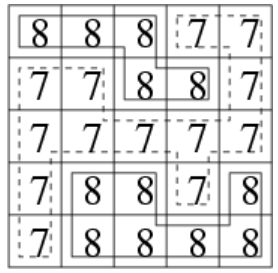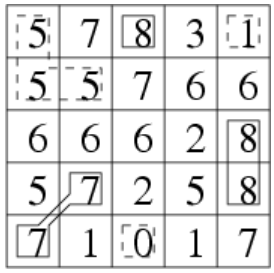\color{Red}{山峰和山谷——Flood Fill}
这里附带打个广告——————我做的所有的题解
包括基础提高以及一些零散刷的各种各样的题
题目介绍
输入格式
第一行包含一个正整数 n,表示地图的大小。
接下来一个 n×n 的矩阵,表示地图上每个格子的高度 w。
输出格式
共一行,包含两个整数,表示山峰和山谷的数量。
数据范围
1 ≤ n ≤ 1000
0 ≤ w ≤ 10 ^ 9
输入样例1:
5
8 8 8 7 7
7 7 8 8 7
7 7 7 7 7
7 8 8 7 8
7 8 8 8 8
输出样例1:
2 1
样例解释1

输入样例2:
5
5 7 8 3 1
5 5 7 6 6
6 6 6 2 8
5 7 2 5 8
7 1 0 1 7
输出样例2:
3 3
样例解释2

思路
思路仍然是Flood Fill 的模板,但是这道题不同的是,我们有一个如果平面高度均相同就既是山谷也是山峰的条件。
同时如果既有比它高的联通块,又有比它低的连通块,就什么也不算。
综合考虑我们就不能在if 条件下靠成立进行自增,而是在不满足的情况下自增,且不需要else if进行分支。
java
import java.io.BufferedReader;
import java.io.IOException;
import java.io.InputStreamReader;
public class Main {
static int N = 1010, n, peek, valley;
static boolean[][] st = new boolean[N][N];
static int[][] h = new int[N][N];
static PII[] q = new PII[N * N];
static boolean has_higher, has_lower;
static BufferedReader br = new BufferedReader(new InputStreamReader(System.in));
static class PII {
int x, y;
public PII(int x, int y) {
this.x = x;
this.y = y;
}
}
private static void bfs(int x, int y) {
int hh = 0, tt = 0;
q[hh] = new PII(x, y);
st[x][y] = true;
while (hh <= tt) {
PII t = q[hh++];
for (int i = t.x - 1; i <= t.x + 1; i++) {
for (int j = t.y - 1; j <= t.y + 1; j++) {
if (t.x == i && t.y == j) continue;
if (i < 0 || i >= n || j < 0 || j >= n) continue;
if (h[i][j] != h[t.x][t.y]){
if (h[i][j] > h[t.x][t.y]) has_higher = true;
if (h[i][j] < h[t.x][t.y]) has_lower = true;
}
else if (!st[i][j]){
st[i][j] = true;
q[++tt] = new PII(i, j);
}
}
}
}
}
public static void main(String[] args) throws IOException {
n = Integer.parseInt(br.readLine());
for (int i = 0; i < n; i++) {
String[] s = br.readLine().split(" ");
for (int j = 0; j < n; j++) h[i][j] = Integer.parseInt(s[j]);
}
for (int i = 0; i < n; i++)
for (int j = 0; j < n; j++)
if (!st[i][j]) {
bfs(i, j);
if (!has_higher) peek++;
if (!has_lower) valley++;
has_higher = false;
has_lower = false;
}
System.out.println(peek + " " + valley);
}
}

